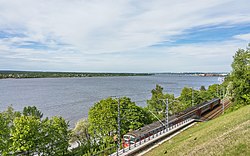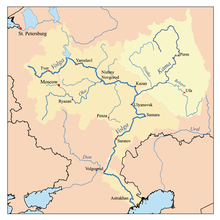This article needs additional citations for verification. (January 2014) |
| Kama | |
|---|---|
 The Kama River in the city of Perm | |
 Map of the Volga's watershed with the Kama's watershed highlighted | |
| Native name | Кама (Russian) |
| Location | |
| Country | Russia |
| Physical characteristics | |
| Source | Kama (river) |
| • location | Kuliga, Udmurtia |
| • coordinates | 58°11′20″N 53°45′00″E / 58.189°N 53.750°E |
| • elevation | 360 m (1,180 ft) |
| Mouth | Volga River |
• location | Kamsko-Ustyinsky District, Tatarstan |
• coordinates | 55°21′50″N 49°59′52″E / 55.36389°N 49.99778°E |
• elevation | 45 m (148 ft) |
| Length | 1,805 km (1,122 mi) |
| Basin size | 507,000 km2 (196,000 sq mi) |
| Discharge | |
| • average | 4,100 m3/s (140,000 cu ft/s) 4,320 m3/s (153,000 cu ft/s) |
| Basin features | |
| Progression | Volga→ Caspian Sea |
 | |
The Kama (UK: /ˈkæmə/ KA-mə, US: /ˈkɑːmə/ KAH-mə; Russian: Кама [ˈkamə]; Udmurt: Кам), also known as the Chulman (/tʃuːlˈmɑːn/ chool-MAHN; Tatar: Чулман / Çulman [tɕuɫˈmɑn]), is a 1,805-kilometre (1,122 mi) long[1][2] river in Russia. It has a drainage basin of 507,000 square kilometres (196,000 sq mi).[2] It is the longest left tributary of the Volga and the largest one in discharge. At their confluence, in fact, the Kama is even larger in terms of discharge than the Volga.
It starts in the Udmurt Republic, near Kuliga, flowing northwest for 200 kilometres (120 mi), turning northeast near Loyno for another 200 kilometres (120 mi), then turning south and west in Perm Krai, flowing again through the Udmurt Republic and then through the Republic of Tatarstan, where it meets the Volga south of Kazan.
Before the advent of railroads, important portages connected the Kama with the basins of the Northern Dvina and the Pechora. In the early 19th-century the Northern Ekaterininsky Canal connected the upper Kama with the Vychegda River (a tributary of the Northern Dvina), but was mostly abandoned after just a few years due to low use.
The Kama featured in the 2013 Russian film The Geographer Drank His Globe Away, in the climactic rapids scene.
- ^ "Definition of Kama River in English". Oxford Dictionaries. Oxford University Press. Archived from the original on March 8, 2016. Retrieved January 11, 2014.
- ^ a b «Река КАМА», Russian State Water Registry